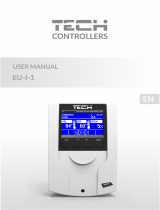3
TABLE OF CONTENTS
I. Safety ......................................................................................................................................................................... 5
II. Device description ..................................................................................................................................................... 6
III. Principle of operation ................................................................................................................................................ 6
IV. How to install the controller ..................................................................................................................................... 7
V. First start-up .............................................................................................................................................................. 9
1. How to configure internet connection ..................................................................................................................... 9
2. How to configure external sensor ............................................................................................................................ 9
3. How to configure temperature sensors and room regulators ................................................................................. 9
4. How to configure wireless thermostatic actuators STT-868/STT-869 (software version2.1.8 and later) .............. 10
5. How to configure window sensors ........................................................................................................................ 11
VI. Wireless communication ......................................................................................................................................... 11
VII. Main screen description .......................................................................................................................................... 12
VIII. Controller functions ................................................................................................................................................. 15
1. Block diagram - controller menu ............................................................................................................................ 15
2. Zones ...................................................................................................................................................................... 15
2.1. Registration.................................................................................................................................................... 15
2.2. ON .................................................................................................................................................................. 16
2.3. Type of sensor ............................................................................................................................................... 16
2.4. Pre-set temperature ...................................................................................................................................... 16
2.5. Hysteresis....................................................................................................................................................... 16
2.6. Calibration ..................................................................................................................................................... 16
2.7. Actuators ....................................................................................................................................................... 16
2.8. Window sensors ............................................................................................................................................ 17
3. External sensor ....................................................................................................................................................... 18
4. Voltage-free contact ............................................................................................................................................... 18
4.1. Zones ............................................................................................................................................................. 18
4.2. Activation delay ............................................................................................................................................. 18
4.3. Additional contact ......................................................................................................................................... 18
5. Fitter’s menu .......................................................................................................................................................... 19
5.1. Internet module ........................................................................................................................................ 20
5.2. Protections ................................................................................................................................................. 20
5.3. Time settings .............................................................................................................................................. 20
5.4. Screen settings .......................................................................................................................................... 21
5.5. Language ........................................................................................................................................................ 21
5.6. Service menu .............................................................................................................................................. 21
5.7. Factory settings ......................................................................................................................................... 21





























